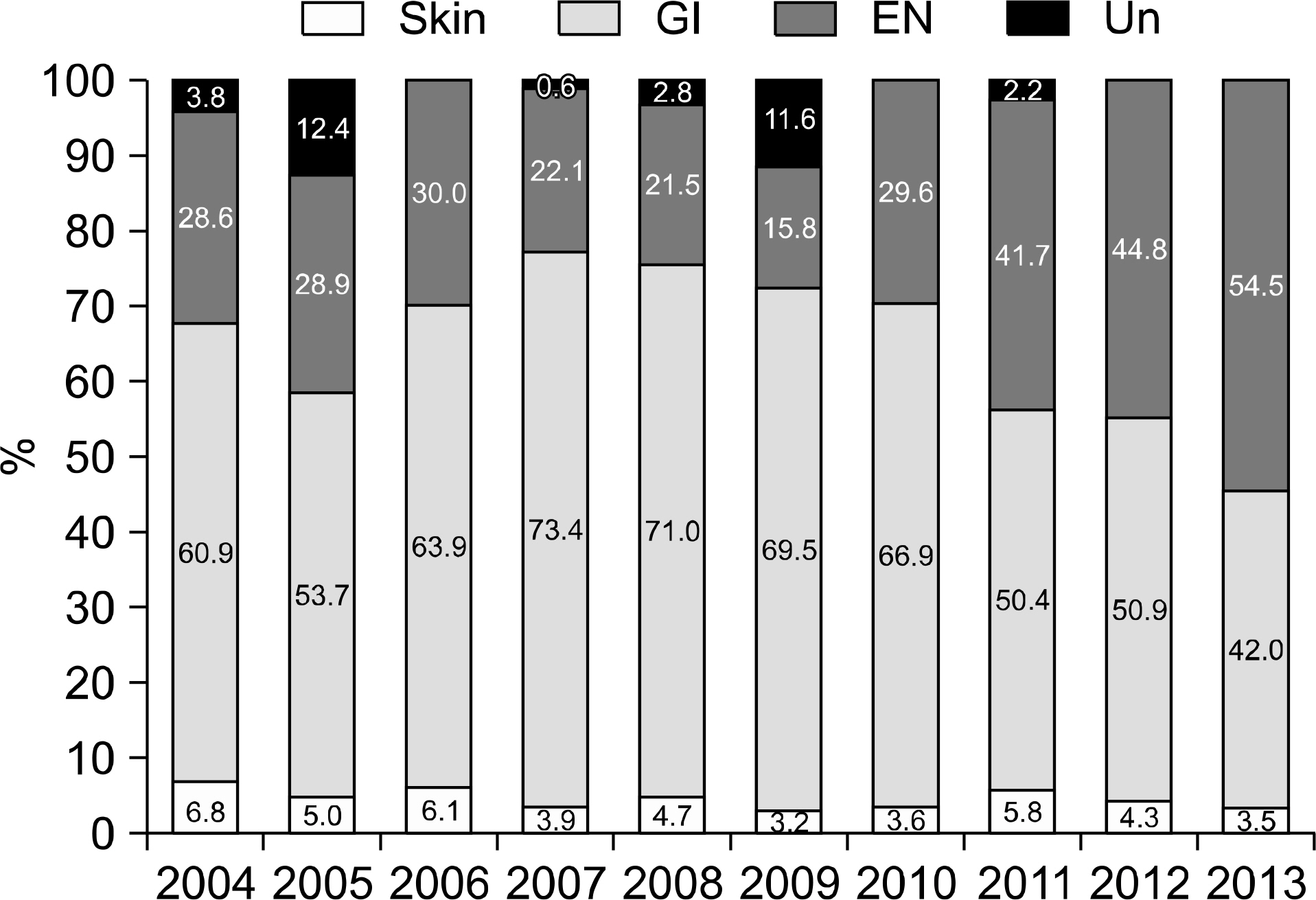Ann Clin Microbiol.
2016 Mar;19(1):1-6. 10.5145/ACM.2016.19.1.1.
Microbial Contamination and Evaluation of Inoculum Volume in Umbilical Cord Blood Culture
- Affiliations
-
- 1Biomedical Research Institute, MEDIPOST Co., Ltd., Seongnam, Korea. simma88@medi-post.co.kr
- KMID: 2160078
- DOI: http://doi.org/10.5145/ACM.2016.19.1.1
Abstract
- BACKGROUND
Microbial screening tests of umbilical cord blood (UCB) are essential for stem cell transplantation. We analyzed the microbial contamination rate and distribution of isolated microorganisms over 10 years of samples from the MEDIPOST Cord Blood Bank. In addition, we studied the influence of inoculum volume microorganism culture and compared the yield and speed of microorganism detection.
METHODS
Microbial screening tests were performed using a manual method, which includes using an inoculum of 2 mL of plasma, a byproduct of UCB processing from pediatric culture bottles. When positive blood culture was detected, each set was once again inoculated with 2 mL and 4 mL of plasma.
RESULTS
From 2004 to 2013, a total of 133,610 UCB units were screened, of which 1,311 (0.9%) tested positive for contamination. The most frequently identified microorganism was Escherichia coli (34.6%), followed by Bacillus spp. (12.8%), Enterococcus faecalis (5.3%) and Klebsiella pneumoniae (4.4%). The total yield rate increased by 0.2% over this time period, although the yield rate of Bacillus spp. increased by 8.3%.
CONCLUSION
The results of this study could be used in many ways with both domestic and international data regarding cord blood contamination. Also, other microbiology laboratories using culture conditions similar to ours could refer this study when preparing guidelines. Finally, by detecting low levels of bacteria, we have contributed to cord blood safety.
Keyword
MeSH Terms
Figure
Reference
-
References
1. Lee YH. Cord blood-current status and perspective. Korean J Hematol. 2007; 42:181–96.2. Clark P, Trickett A, Stark D, Vowels M. Factors affecting microbial contamination rate of cord blood collected for transplantation. Transfusion. 2012; 52:1770–7.
Article3. Park JS, Shin S, Yoon JH, Roh EY, Chang JY, Kim EC. Microbial contamination of donated umbilical cord blood. Ann Clin Microbiol. 2013; 16:39–44.
Article4. Umbilical Cord Blood Management and Research Act. Korea Ministry of Health and Welfare, 2011. http://law.go.kr/. [Online] (last visited on 30 November 2015).5. Kamble R, Pant S, Selby GB, Kharfan-Dabaja MA, Sethi S, Kratochvil K, et al. Microbial contamination of hematopoietic progenitor cell grafts-incidence, clinical outcome, and cost-effectiveness: an analysis of 735 grafts. Transfusion. 2005; 45:874–8.
Article6. Weinstein MP, Mirrett S, Wilson ML, Reimer LG, Reller LB. Controlled evaluation of 5 versus 10 milliliters of blood cultured in aerobic BacT/Alert blood culture bottles. J Clin Microbiol. 1994; 32:2103–6.
Article7. Park DS, Lee YJ, Yoo SJ, Cho JH. Evaluation of positive rate of aerobic BacT/Alert blood culture bottles by antibiotic usage and inoculated blood volume. Korean J Clin Pathol. 2001; 21:343–9.8. Winn WC, Koneman EW, editors. Koneman's color atlas and textbook of diagnostic microbiology. 5th ed.Philadelphia, PA: Lippincott;1997.9. Shin BM and Paik SO. Comparison of vital automated blood culture system and mannual blood culture method. Korean J Clin Microbiol. 1998; 1:97–103.
- Full Text Links
- Actions
-
Cited
- CITED
-
- Close
- Share
- Similar articles
-
- Microbial Contamination of Donated Umbilical Cord Blood
- StemCell Transplantation in Umbilical Cord Blood(II) Characteristics of T-Lymphocyte Subpopulation in Umbilical Cord Blood
- Clinical Characteristics Associated with Blood Culture Contamination in Neonates
- Ureaplasma Contamination Rate in Donated Cord Blood Units
- Six-years' Experience of Pseudomosaicism and Maternal Cell Contamination in Cultured Amniocytes


